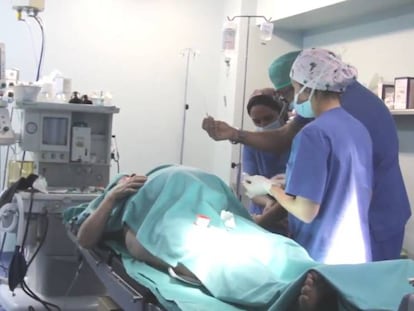What you need to know about giving birth (and keeping it natural) in Madrid
What is available from one hospital to another varies greatly, so check your options early

Walking along Calle de las Huertas in Madrid with the newfound knowledge that I was pregnant, I had a (careful) bounce in my step; I was elated. But by the time I got to Plaza del Ángel, the elation had subsided and I was filled with fear and terror. Not because my life was never going to be the same again, or because I wouldn’t be able to sleep eight hours uninterruptedly for two years. It was because I was about to face the Spanish healthcare system, be pregnant in it, talk to doctors in Spanish in it, and then actually give birth in one of its hospitals.
Don’t get me wrong. The Spanish healthcare system is brilliant and I count myself very lucky to have free access to it. It was the alienness of it that was terrifying. I can speak Spanish, so I didn’t have that to worry about. It was more a case of – how can I do it naturally? My sister had had a home birth in London, and I wanted that here. I had to find out what was and was not possible.
While some hospitals are traditional, others are pioneering when it comes to their maternity ward
I soon found out that there is a great variation of what is available from one hospital to another. While some hospitals are traditional, others are pioneering when it comes to their maternity ward, offering water births, pilates balls, walk-in showers where you can give birth, and music facilities. For the purpose of this post, I called the Doce de Octubre hospital to ask if they offered pool births and was told: “Aquí se pare como toda la vida, i.e. We give birth the good old way here. Hospitals that don’t do it the way it’s always been done include public hospitals Torrejón de Ardoz and Rey Juan Carlos in Móstoles. These are often considered the two pioneering hospitals when it comes to natural, or “respected,”childbirth.
Midwives will take a look at your Birth Plan, so do write one, and go through it with your obstetrician ahead of the big day. It’s a good thing to do, to know what kinds of things you want and don’t want, and to know that the hospital is on the same page as you. You might not want an epidural, or maybe you want a ‘walking epidural’. Express your wishes, at the same time as being aware that circumstances may change and you might be induced, which may or may not change the course of events. (I was induced, and had a wonderful, natural birth.) You can visit as many hospitals as you like on their open days. Just phone them and ask for the dates. Questions to ask might be about Birth Plans, facilities, their Caesarean protocol, whether a partner and skin-to-skin with the newborn is allowed, along with information about epidurals and their neonatal units.
Private vs public
If, like me, you have private health insurance, you may consider going privately. If that’s what you want, go for it. Just bear in mind that, according to the Ministry of Health, the rate of C-sections in Spain is around 25.2% of live births, whereas in the private sector 28% to 38% of women have their babies via caesarean. I had Sanitas healthcare and wanted to gauge the attitude of the gyno team that would attend me at Sanitas Zarzuela, where I was allocated, so I asked about birthing positions. My gynecologist informed me they preferred the patient to be lying on their back. After my reading, and knowing that gravity is a laboring woman’s great friend, and a whole range of other positions are available to her, I knew this team was not for me. As she said, they prefer it because they have better visibility. Frankly, I don’t care about their visibility.
That was me. Do whatever works for you. But if you like the ethos of one hospital more than the one you’ve been assigned, change. And you can – it’s one of your patient rights. Just go to the Atención al cliente or Patient Information room of your allocated hospital and fill out a form ¡y ya está!
If, like me, you have private health insurance, you may consider going privately
You should also be aware of the Kristeller manoeuvre. The manoeuvre – when someone forcefully presses down on the mother's uterus in a series of sharp, violent movements, or squeezing with an arm or strap – is meant to create fundal pressure, and is allowed in Spain only in the second, or ‘pushing’, phase of a slow labor. It is illegal in other countries, including Great Britain. According toThe Well-Rounded Mama, a study found that doctors used fundal pressure nearly 70% of the time in prolonged pushing phases, and in 26.1% of births in Spain. This painful move can also harm the baby, causing shoulder dystocia, uterine rupture; rupture of the bladder; sphincter injuries, brain damage to the neonate. It can understandably be traumatizing for both mother and baby. Make it clear you do not want this verbally and in a Birth Plan, and have your partner onside to step in if a midwife says she’s going to help the baby ‘move down’.
Midwives and hospitals aside, there is a growing range of professionals available to women today. Hypnobirthing (the learning of breathing techniques to enter a deep state of relaxation, thus doing away with fear and pain) courses are available in Madrid. I did one with Pilar and it transformed my pregnancy and birth experience. There are also doulas, and support groups. Home birth is also an option for uncomplicated pregnancies, but it comes with a cost of about €2,000. Check out the brilliant Genesis group for more information. Elpartoesnuestro.es is another great website, working to support mothers and their babies.
A last word of advice: don’t take it to heart if healthcare professionals are a little more ‘direct’ than you’re used to. The bedside manner isn’t as hot in Spain as the temperatures are. What you can do is ask for them to explain what they will do, ahead of doing it, and inform you along the way. Get your partner/companion to ask questions, too.
Tu suscripción se está usando en otro dispositivo
¿Quieres añadir otro usuario a tu suscripción?
Si continúas leyendo en este dispositivo, no se podrá leer en el otro.
FlechaTu suscripción se está usando en otro dispositivo y solo puedes acceder a EL PAÍS desde un dispositivo a la vez.
Si quieres compartir tu cuenta, cambia tu suscripción a la modalidad Premium, así podrás añadir otro usuario. Cada uno accederá con su propia cuenta de email, lo que os permitirá personalizar vuestra experiencia en EL PAÍS.
¿Tienes una suscripción de empresa? Accede aquí para contratar más cuentas.
En el caso de no saber quién está usando tu cuenta, te recomendamos cambiar tu contraseña aquí.
Si decides continuar compartiendo tu cuenta, este mensaje se mostrará en tu dispositivo y en el de la otra persona que está usando tu cuenta de forma indefinida, afectando a tu experiencia de lectura. Puedes consultar aquí los términos y condiciones de la suscripción digital.
More information
Archived In
Últimas noticias
Most viewed
- Reinhard Genzel, Nobel laureate in physics: ‘One-minute videos will never give you the truth’
- Oona Chaplin: ‘I told James Cameron that I was living in a treehouse and starting a permaculture project with a friend’
- Pablo Escobar’s hippos: A serious environmental problem, 40 years on
- Charles Dubouloz, mountaineering star, retires at 36 with a farewell tour inspired by Walter Bonatti
- Why we lost the habit of sleeping in two segments and how that changed our sense of time










































